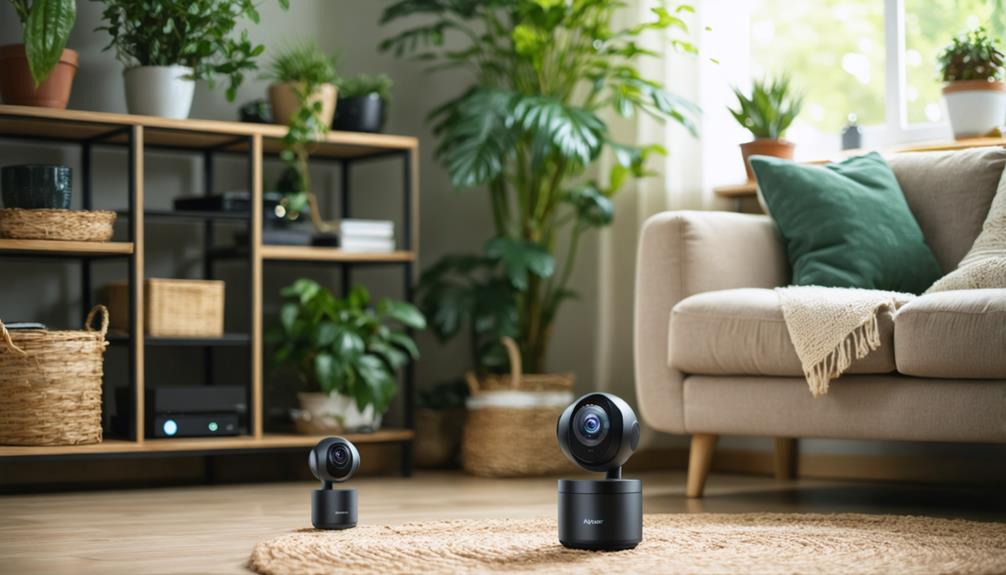
Brainstorm Security Shop

For Orders Over $199

On Any Of Our Products

Details On Refund Page
When considering mini indoor cameras, you might find yourself weighing their benefits against privacy concerns. These compact devices can seamlessly integrate into your home, offering a range of features from motion detection to high-resolution video. However, the implications of having a camera in every corner of your living space can raise questions. What should you prioritize: security or privacy? As you explore the options available, you’ll discover key factors that could influence your decision, leading to a more informed choice about what best suits your needs.
Mini indoor cameras offer numerous advantages that can enhance your home security and peace of mind. One of the key benefits is their surveillance effectiveness. With these cameras, you can monitor your home in real-time, ensuring you’re always aware of what’s happening, whether you’re at home or away.
Their discreet monitoring capabilities allow you to keep an eye on your space without being intrusive. You won’t have to worry about bulky equipment or unsightly installations. Instead, these cameras come with a space-saving, unobtrusive design that easily blends into your home decor.
You can place them in various locations, capturing every angle without drawing attention to them.
Moreover, mini indoor cameras can deter potential intruders, knowing they’re being watched. This added layer of security can significantly improve your overall sense of safety. Plus, many models offer features like motion detection and notifications, so you’ll be alerted immediately if something seems amiss.
With these advantages, integrating mini indoor cameras into your home security strategy can be a smart choice, providing you with peace of mind and enhanced protection for your loved ones and belongings.
When choosing an indoor camera, several key features can make a significant difference in its effectiveness and usability. One of the first things to consider is size comparison. You want a camera that fits seamlessly into your space without being obtrusive. A compact design can be ideal for discreet monitoring.
Next, camera resolution is crucial for clear images and videos. Higher resolution ensures that you’ll capture finer details, which can be particularly important for identifying faces or reading license plates. Aim for at least 1080p resolution for optimal clarity.
Additionally, think about how you’ll access your camera’s footage. A user-friendly mobile app can enhance your experience, allowing you to view live feeds and recorded footage easily. Look for apps that offer real-time notifications and remote control features.
As you explore your options, you’ll find several popular models on the market that cater to different needs and preferences. One standout is the Wyze Cam v3, known for its excellent video quality and affordability. It offers 1080p HD resolution and great low-light performance, making it ideal for various camera placements around your home.
Another popular choice is the Arlo Essential Indoor Camera, which excels in both video quality and user-friendly features. With its 1080p video and two-way audio, you can easily monitor your space while communicating with anyone present.
The compact design allows for versatile camera placement, whether on a shelf or mounted on a wall.
If you’re looking for something more discreet, the Blink Mini is a great option. This tiny camera packs a punch with 1080p video quality and motion detection alerts. Its small size means you can easily tuck it away in different locations without drawing attention.
How can you ensure a smooth installation and setup for your mini indoor camera?
First, think about camera placement. Choose a spot that provides a clear view of the area you want to monitor while avoiding obstructions. High corners often work well, but ensure it’s within reach for adjustments or maintenance.
Next, make sure you have a stable Wi-Fi connection if your camera relies on remote monitoring. Before you install, check the signal strength in your chosen location. If the signal’s weak, consider moving the camera or using a Wi-Fi extender.
Once you’ve decided on the placement, follow the manufacturer’s instructions for setup. Download the app, create an account, and connect your camera to your Wi-Fi network. During this process, you’ll usually need to scan a QR code or enter a pairing code.
After installation, test the camera’s live feed through the app to ensure everything’s working correctly. Adjust the angle if necessary to capture the best view. Finally, familiarize yourself with the app’s features for remote monitoring, like motion alerts or cloud storage options, to maximize your camera’s potential.
After setting up your mini indoor camera, it’s important to address privacy and security concerns that may arise. These cameras can provide peace of mind, but they also raise potential issues regarding privacy. You need to be aware of who’s access to the footage and how it’s being stored. Unauthorized access to your camera could lead to serious privacy concerns, especially if sensitive areas of your home are monitored.
To safeguard your data security, always change the default passwords on your devices. Use strong, unique passwords that are difficult to guess. Enable two-factor authentication if available, as this adds an extra layer of protection. Regularly check for software updates to ensure your camera has the latest security features.
Additionally, consider where you place your cameras. Avoid positioning them in private spaces like bedrooms or bathrooms to respect the privacy of everyone in your home.
It’s crucial to inform family members or visitors about the cameras so they know what to expect. By taking these precautions, you can enjoy the benefits of your mini indoor camera while minimizing privacy concerns and enhancing data security.
When it comes to enhancing your home security, mini indoor cameras offer a range of practical use cases for homeowners. One of the most popular applications is remote monitoring. With these compact cameras, you can check in on your home from anywhere using your smartphone. Whether you’re at work or on vacation, you’ll have peace of mind knowing you can see what’s happening inside your home in real-time.
Another great use case is pet surveillance. If you’re a pet owner, mini cameras allow you to keep an eye on your furry friends while you’re away. You can watch their antics, ensure they’re safe, and even talk to them through two-way audio features. This can be particularly helpful for training purposes, as you can intervene if needed.
Additionally, you can use these cameras to monitor household help or babysitters, ensuring your loved ones are in a safe environment.
The versatility of mini indoor cameras makes them an excellent choice for homeowners looking to enhance security, provide pet care, and maintain a watchful eye on their living space.
To connect to Wi-Fi networks, you’ll need to follow the Wi-Fi setup instructions. If you encounter issues, troubleshooting can help. Also, consider camera placement for optimal coverage to ensure effective monitoring throughout your space.
Yes, you can access your camera remotely through various remote viewing options. Just remember to address any privacy concerns, ensuring your network’s security to keep your footage safe from unauthorized access.
The average battery life varies widely based on battery performance and power consumption. You’ll typically find it ranges from a few hours to several weeks, depending on usage and settings. Consider optimizing settings for better longevity.
Most mini cameras aren’t weatherproof, limiting outdoor compatibility. If you’re considering installation and setup for outdoor use, ensure you choose models designed for durability to withstand elements like rain and extreme temperatures.
Many devices support voice commands and smart home integration, enhancing convenience. However, consider privacy concerns and ensure strong security features are in place to protect your personal information from potential vulnerabilities in these systems.
